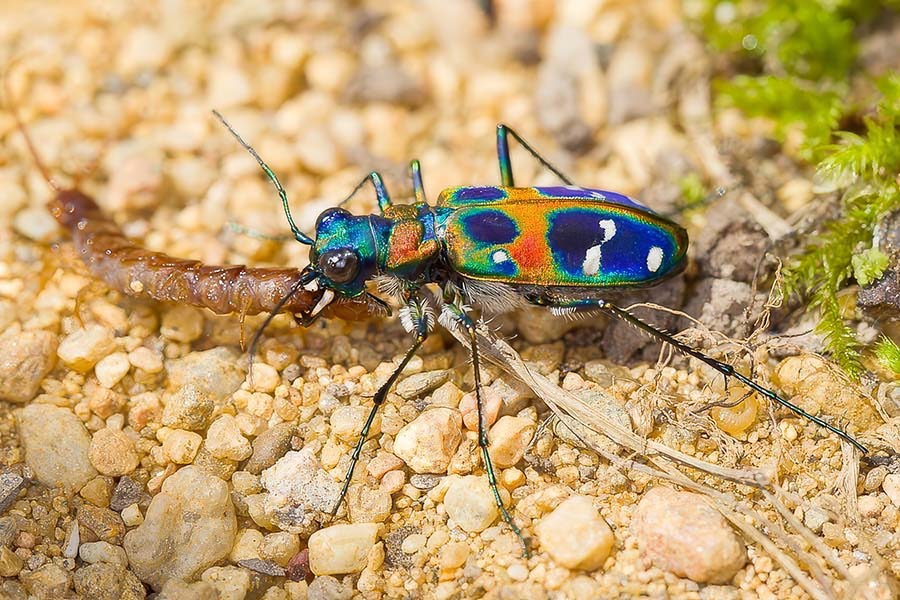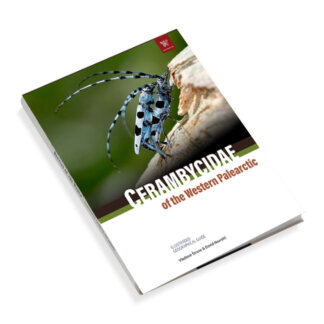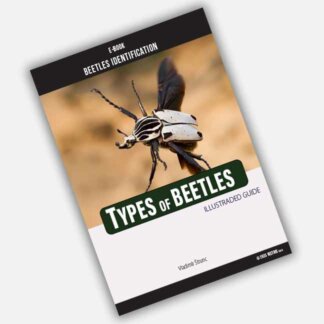Unique pictorial atlases for identifying Beetles. Cicindelidae, commonly known as tiger beetles, is a family of beetles comprising over 2,600 species.
Cicindelidae, commonly known as tiger beetles, represent a diverse group of predatory insects renowned for their remarkable hunting abilities, distinctive appearance, and ecological significance. These beetles, characterized by their vibrant metallic coloration and incredible speed, are found across various habitats worldwide with particularly high diversity in tropical and subtropical regions. Their specialized hunting strategies and unique life cycles have made them subjects of scientific interest for entomologists studying predator-prey dynamics and insect adaptations.
Are you a student or interested in entomology? Don’t miss the exclusive discounts offered by the author! Contact today for special pricing for students and entomologists – save money and support your curiosity and studies at the same time. Contact us now to take advantage of this opportunity! You will receive a reply promptly
Taxonomic Classification and Diversity
Tiger beetles have undergone some taxonomic reclassification over time, traditionally placed within the family Cicindelidae, order Coleoptera. The complete taxonomic hierarchy positions them within Eukaryota (superkingdom), Animalia (kingdom), Bilateria (subkingdom), Protostomia (infrakingdom), Ecdysozoa (superphylum), Arthropoda (phylum), Hexapoda (subphylum), Insecta (class), Pterygota (subclass), Neoptera (infraclass), Holometabola (superorder), Coleoptera (order), and Adephaga (suborder). Common tiger beetles
Book novelties:
Prioninae of the World I., Cerambycidae of the Western Paleartic I. June Bugs,
Types of beetles insects
New E-Book: Ground Beetles, Tiger Beetles, Longhorn Beetles, Jewel Beetles, Stag Beetles, Carpet Beetles, Scarab Beetles, Rhinoceros Beetles, Weevil Beetles, Blister Beetles, Leaf Beetles, Flower Beetles,
More recent classifications, however, consider them as the subfamily Cicindelinae within the family Carabidae (ground beetles). This taxonomic family comprises more than 2,600 species of beetles, organized into numerous genera and tribes including Cicindelini, Collyridini, Ctenostomatini, Manticorini, Megacephalini, and Oxycheilini.
The diversity of tiger beetles continues to be refined through ongoing taxonomic research. For instance, recent molecular and morphological analyses have revealed the need for new genera to accommodate distinct evolutionary lineages. One example is the establishment of Jundlandia, a new genus created to accommodate the unique characteristics of Cylindera lemniscata, which previous studies had difficulty placing within the Nearctic fauna due to its peculiar morphological features. Such taxonomic revisions highlight the complexity and evolutionary diversity within this group.
Regional biodiversity studies further demonstrate the widespread distribution of these beetles. In Pakistan alone, researchers have documented 55 taxa under 14 genera and 11 subgenera, with species like Cylindera albopunctata, Cicindela viridilabris, and Neocollyris redtenbacheri being recorded in the country for the first time in recent years. This continuous discovery of new regional records underscores the wide but still incom
Tiger Beetles
Family Cicindelidae
These insects are characterized by their predatory behavior, vibrant colors, and remarkable speed. They are primarily found in subtropical and tropical regions, often inhabiting sunny paths or sandy areas. Book about Beetles
Cicindelidae
Start Shopping, Start Saving – prices from $3 USD
We recommend:
jeweled beetles, ground beetles, longhorn beetles, goliath beetle, stag beetle, carpet beetles
Tiger Beetles
Family Cicindelidae
Books about Beetles
Unique pictorial atlases for identifying Beetles:
(2020) Tiger Beetles of the World, Cicindelidae, Illustrated guide to the genera
(2023) Tiger Beetles of Africa, Cicindelidae, Geographical guide to the family Cicindelidae
(2024) Tiger Beetles of Orient, Cicindelidae, Geographical guide to the family Cicindelidae
(2022) Ground Beetles of Africa, Afrotropical Region
(2022) Jewel Beetles of the World, Buprestidae, Illustrated guide to the Superfamily Buprestoidea
(2008) The Prionids of the World, Prioninae, Illustrated catalogue of the Beetles
(2010) The Prionids of the Neotropical region, Prioninae, Illustrated catalogue of the Beetles
Common tiger beetles
Cicindelidae: The Tiger Beetles
pletely documented global distribution of tiger beetles.
Evolutionary Relationships
The evolutionary relationships among tiger beetles have been investigated using both traditional morphological approaches and more recent molecular phylogenetic studies. These analyses have revealed complex patterns of relatedness among different groups. For example, molecular studies from the late 1990s and early 2000s struggled to reach consensus about the systematic placement of certain species like Cylindera lemniscata, which was later determined through mtDNA genealogy to represent a monotypic clade sister to a larger group of Nearctic tiger beetles.
These phylogenetic studies continue to provide insights into the evolutionary history of tiger beetles, including patterns of adaptive radiation, biogeographic distribution, and morphological specialization across different habitats and ecological niches. The ongoing refinement of tiger beetle taxonomy reflects the dynamic nature of systematic biology and the importance of integrative approaches combining molecular, morphological, and ecological data.
Physical Characteristics
Tiger beetles possess a distinctive combination of morphological features that make them readily identifiable among beetle families. These predatory insects typically have slender, long-legged bodies measuring approximately 10 to 20 mm (0.4 to 0.8 inch) in length. One of their most notable features is their large, bulging eyes that provide exceptional vision – a critical adaptation for their predatory lifestyle that allows them to detect movement quickly in their environment.
The coloration of tiger beetles is particularly striking, with many species displaying iridescent hues of blue, green, orange, or scarlet. This vibrant appearance results from a combination of two factors: pigments embedded within their exoskeleton and structural colors created by the refractory properties of their exoskeletal surface.
This dual mechanism of color production contributes to the metallic sheen that makes many species visually spectacular. The coloration often serves adaptive purposes, with species inhabiting sandy areas frequently displaying lighter colors that match their environment, providing effective camouflage.
Morphological Adaptations
Tiger beetles possess several specialized adaptations that enhance their predatory capabilities. Their most prominent feature is the pair of long, sharp mandibles capable of inflicting painful bites when handled. These mandibles serve as powerful grasping tools for capturing and dismembering prey. The six-spotted tiger beetle (Cicindela sexguttata), a common species in eastern North America, exemplifies the typical morphology with its shiny bluish-green coloration and distinctive pattern of six white markings on its elytra (wing covers).
The wing covers (elytra) of many tiger beetle species, particularly those in the genus Cicindela, feature scroll-like markings that create distinctive patterns. These markings vary considerably between species and can serve as important diagnostic characteristics for identification. The combination of specialized mouthparts, keen vision, and agile body design makes tiger beetles exceptionally effective predators in their respective habitats.
Hunting Behavior and Predatory Adaptations
Tiger beetles have earned their common name from their remarkably aggressive hunting tactics and voracious appetite. Both the larvae and adults are predaceous, though they employ drastically different hunting strategies due to their distinct lifestyles. These beetles have developed specialized adaptations that make them formidable predators within their ecosystems.
Adult tiger beetles are renowned for their exceptional speed and agility. They are among the fastest insects on Earth, with the Australian species Rivacindela hudsoni (formerly Cicindela hudsoni) capable of reaching speeds of 2.5 meters per second (approximately 5.6 mph) or about 125 body lengths per second. This remarkable mobility allows adults to actively pursue and capture prey with impressive efficiency. They patrol open areas, using their excellent vision to detect potential prey, then sprint forward to seize victims with their powerful mandibles.
Larval Hunting Strategy
While adult tiger beetles employ active hunting tactics, the larvae utilize an entirely different approach based on ambush predation. Larvae construct and inhabit vertical burrows or tunnels in hard-packed soil or sand, which can reach depths of up to 60 cm (2 feet). The larva positions itself at the entrance of this burrow, using specialized hooks on the dorsal side of its fifth abdominal segment to anchor itself in place. These hooks serve a dual purpose: they secure the larva at the burrow entrance while waiting for prey and provide stability when dragging struggling prey into the depths of the tunnel.
When potential prey—typically insects or spiders—passes within striking distance, the larva lunges out with remarkable speed, grasping the victim with its sickle-like mandibles. The abdominal hooks prevent the larva from being pulled out of its burrow during the struggle with larger prey. Once captured, the prey is dragged to the bottom of the burrow, where it is consumed. This sophisticated ambush strategy allows the relatively immobile larvae to effectively capture prey while remaining protected from potential predators.
Habitat and Distribution
Tiger beetles demonstrate remarkable ecological versatility, occurring throughout the world across a diverse range of habitats, though the highest species diversity is found in subtropical and tropical regions. Their specific habitat preferences vary considerably between species, but most are typically associated with open, exposed areas that receive ample sunlight. Common habitats include sandy beaches, riverbanks, salt flats, woodland paths, roadways, and forest clearings.
The preference for open, sunny habitats aligns with the beetles’ visual hunting strategy, as their excellent eyesight functions optimally in well-lit environments. Different species have adapted to specific microhabitats, with some specialized to live exclusively in particular soil types or ecological zones. For example, some species prefer sandy coastal areas, while others inhabit clay soils in forest clearings or rocky surfaces in mountainous regions.
Specialized Habitat Adaptations
While most tiger beetles are terrestrial ground-dwellers, ecological specialization has led to the evolution of several alternative lifestyles within the family. Some exotic tropical species have developed associations with termite nests, forming complex ecological relationships with these social insects.
Other tropical species have adapted to arboreal (tree-dwelling) lifestyles, hunting prey on tree trunks and vegetation rather than on the ground. Additionally, certain species have evolved semi-aquatic habits, living near water bodies and sometimes hunting on water surfaces.
The global distribution of tiger beetles encompasses multiple biogeographical realms. Studies from Pakistan have documented species belonging to both Palearctic and Oriental biogeographical zones, highlighting the wide-ranging distribution of these insects. The regional distribution patterns often reflect adaptations to local climatic conditions and habitat availability, with species composition varying significantly between different geographical areas.
Life Cycle and Development
The life cycle of tiger beetles involves complete metamorphosis (holometabolism), progressing through egg, larval, pupal, and adult stages. The reproductive process begins when female tiger beetles select suitable oviposition sites in soil, often in the same habitat types where adults hunt. The female excavates small cavities less than half an inch deep in the soil and deposits single, ovate, translucent eggs.
Upon hatching, the larvae immediately begin constructing their characteristic vertical burrows in the soil or sand. These burrows serve as both protective retreats and hunting platforms throughout the larval development period. Tiger beetle larvae undergo three instars (developmental stages), with the entire larval phase potentially lasting one to three years depending on the species and environmental conditions.
You can find here: Carabidae, Buprestidae, Cicindelidae, Scarabaeidae, Lucanidae, Chrysomelidae, Curculionidae, Staphylinidae
Developmental Adaptations
The larvae exhibit specialized morphological adaptations suited to their ambush predator lifestyle. Most notably, they possess hooks on the dorsal side of their fifth abdominal segment that anchor them securely within their burrows. This adaptation allows them to position themselves at the entrance of their tunnels while remaining firmly attached to the burrow walls. The larvae also develop powerful, sickle-shaped mandibles that function effectively for grasping and subduing prey.
After completing larval development, the final instar larva seals its burrow and pupates within an enlarged chamber at the bottom. Following metamorphosis, the adult beetle emerges from the pupal case and digs its way to the surface. Adult tiger beetles are typically active during warm seasons, with specific activity patterns varying by species. Some species demonstrate seasonal activity cycles, while others may remain active year-round in suitable climates.
Ecological Significance and Conservation
Tiger beetles serve as important predators within their ecosystems, contributing to the regulation of various insect populations. Their voracious appetite for smaller arthropods makes them valuable components of natural pest control systems. Additionally, as both predators and potential prey for larger animals, they form crucial links in ecological food webs.
Beyond their ecological functions, tiger beetles have attracted scientific interest as potential bioindicators of environmental quality. Their specific habitat requirements and sensitivity to environmental disturbances make certain species useful indicators of ecosystem health. Changes in tiger beetle populations or community composition may signal broader ecological changes or degradation.
Despite their ecological importance, some tiger beetle species face conservation challenges due to habitat loss, pollution, and climate change. Their often specialized habitat requirements make them vulnerable to environmental alterations. While some species have been transported to other countries for potential biological control applications, these efforts have not yielded significant practical results.
Conclusion Cicindelidae
Cicindelidae (tiger beetles) represent a fascinating group of predatory beetles characterized by their striking appearance, remarkable hunting abilities, and ecological adaptations. Their taxonomy continues to evolve as new research illuminates evolutionary relationships among species, while their global distribution demonstrates successful adaptation to diverse habitats across multiple biogeographical regions.
The specialized hunting strategies employed by both adults and larvae highlight the evolutionary refinement of predatory behaviors within this group. Adult tiger beetles, with their exceptional speed and visual acuity, represent some of the most efficient insect predators, while the ambush tactics of larvae demonstrate alternative adaptations to predatory lifestyles.
Future research on tiger beetles may yield additional insights into their evolutionary history, ecological relationships, and potential applications in conservation biology. As indicators of ecosystem health and components of natural pest control systems, these remarkable insects merit continued scientific attention and conservation consideration. Their combination of aesthetic appeal and biological significance makes them valuable subjects for both scientific study and biodiversity conservation efforts.
You can find here: Carabidae, Buprestidae, Cerambycidae, Scarabaeidae, Lucanidae, Chrysomelidae, Curculionidae, Staphylinidae
Family Cicindelidae Latreille, 1802
Tribe Cicindelini Latreille, 1802
- Subtribe Apteroessina Rivalier, 1971
- Subtribe Cicindelina Latreille, 1802
- Subtribe Dromicina J. Thomson, 1859
- Subtribe Iresiina Rivalier, 1971 P
- Subtribe Theratina W. Horn, 1893
Tribe Collyridini Brullé, 1834
- Subtribe Collyridina Brullé, 1834
- Subtribe Tricondylina Naviaux, 1991
Tribe Ctenostomatini Laporte, 1834
Tribe Manticorini Laporte, 1834
Tribe Megacephalini Laporte, 1834
Tribe Oxycheilini J. Thomson, 1857
Physical Characteristics
Tiger beetles are slender and long-legged, typically measuring between 10 to 20 mm in length. They possess large, bulging eyes that aid in their predatory lifestyle. Their exoskeletons can be iridescent blue, green, orange, or scarlet due to both pigments and structural coloration. Many species exhibit distinctive markings on their elytra (wing covers), which can include scroll-like patterns3.
Behavior and Ecology
Tiger beetles are known for their aggressive predation. Both adults and larvae actively hunt various prey such as insects and spiders. The larvae create vertical burrows where they ambush passing prey using sickle-shaped mandibles. Adults are also quick runners and fliers; some species can run at speeds of up to 2.5 meters per second (about 5.6 mph), making them among the fastest insects on Earth.
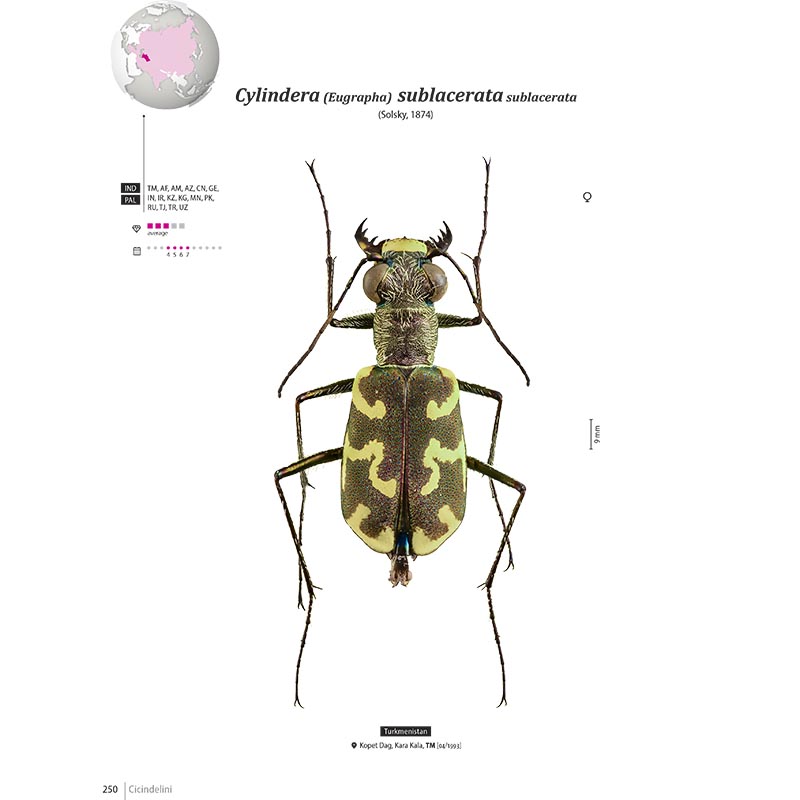
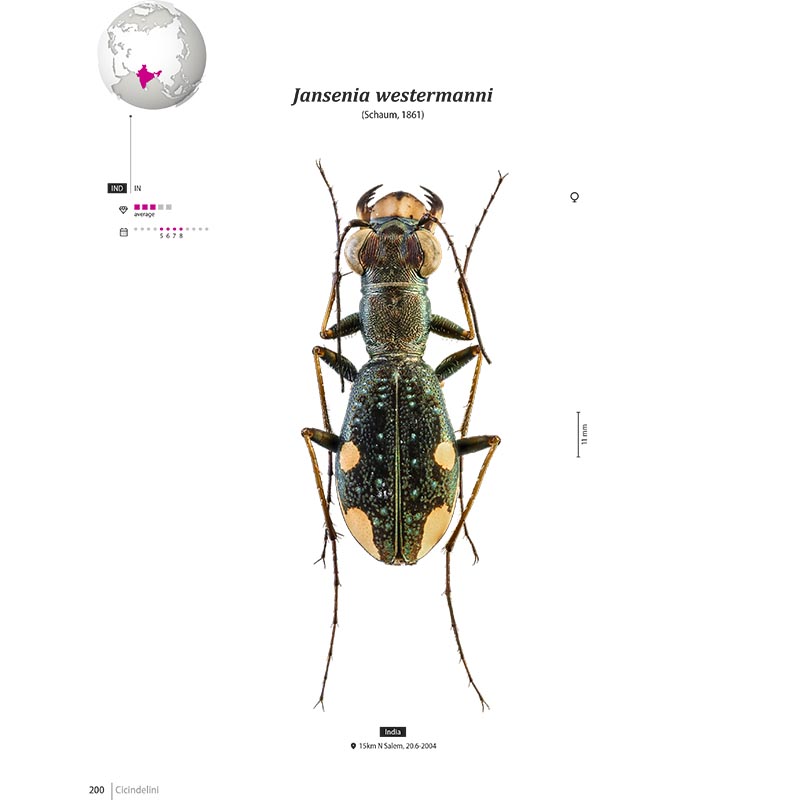

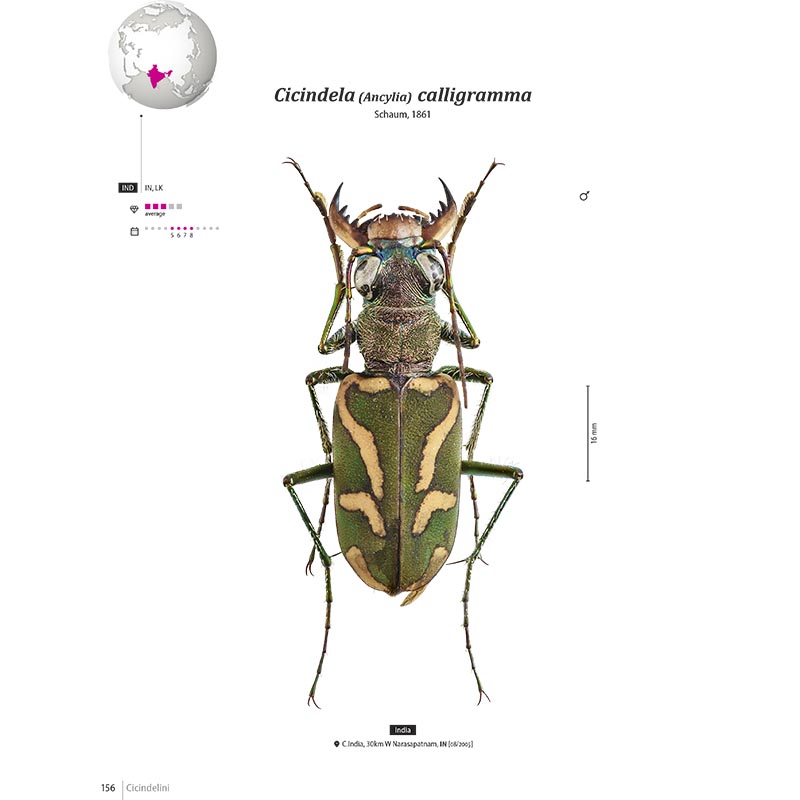
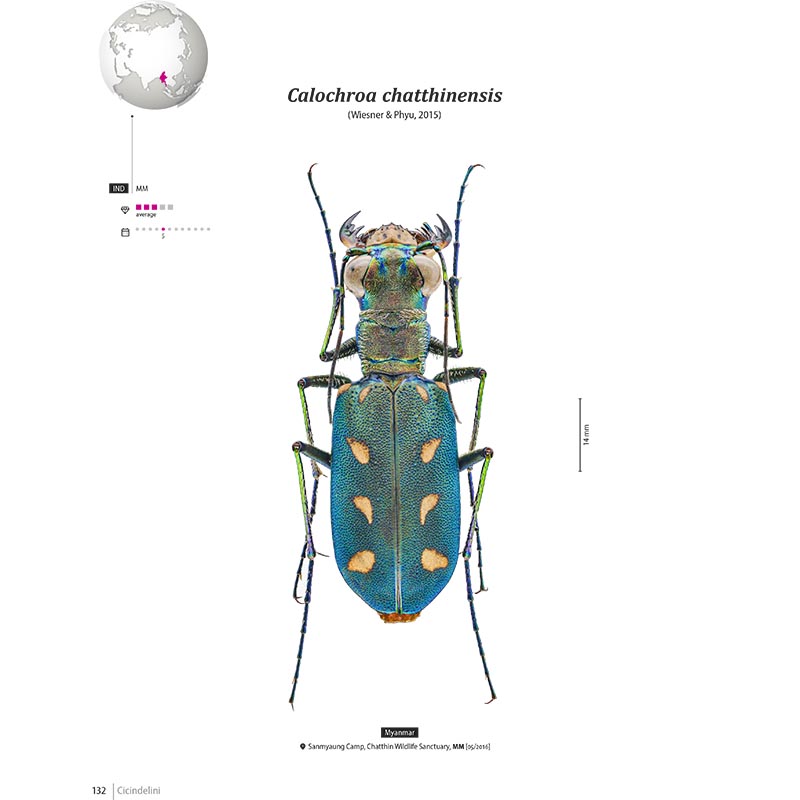

Family Cicindelidae: Advantages and Disadvantages
Introduction
The family Cicindelidae, commonly known as tiger beetles, consists of over 2,600 species of beetles recognized for their predatory habits and impressive speed. These beetles are found worldwide, often inhabiting sunny, sandy areas near bodies of water. This article will explore the advantages and disadvantages associated with the family Cicindelidae.
Advantages
-
Ecological Role: Predation
Tiger beetles are voracious predators, feeding on a variety of insects and spiders. This helps maintain ecological balance by controlling pest populations, which can be beneficial for agriculture and natural ecosystems. -
Biodiversity Indicators
Due to their sensitivity to environmental changes, tiger beetles serve as excellent indicators of biodiversity and ecosystem health. -
Speed and Agility
Tiger beetles are among the fastest insects on Earth, with some species reaching speeds of up to 2.5 meters per second. This speed allows them to efficiently hunt and evade predators. Their agility and rapid movement make them fascinating subjects for scientific study, particularly in the fields of biomechanics and sensory perception. -
Diverse Habitats
Tiger beetles inhabit a wide range of environments, from sandy beaches to woodland paths, contributing to their ecological diversity and adaptability.
Disadvantages
-
Predation Pressure
While tiger beetles help control pest populations, they can also exert significant predation pressure on beneficial insects. This might disrupt local food chains if their populations become too dominant. -
Potential for Overexploitation
The larvae of tiger beetles are often targeted by parasitic wasps, which can lead to overexploitation of certain tiger beetle species. This could impact their populations and ecological roles. -
Limited Defensive Mechanisms
Despite their speed, tiger beetles have limited defensive mechanisms against larger predators. Their reliance on speed and agility makes them vulnerable in certain situations. -
Environmental Sensitivity
Tiger beetles are sensitive to environmental changes, which can make them vulnerable to habitat destruction and climate change. This sensitivity, while useful for monitoring ecosystems, also poses a threat to their survival. -
Bug Posters, Insect Posters

Conclusion
The family Cicindelidae offers numerous ecological benefits, including pest control and biodiversity monitoring. However, their predation activities and environmental sensitivity also present challenges. Understanding these aspects is crucial for managing ecosystems effectively and ensuring the long-term survival of these fascinating insects.
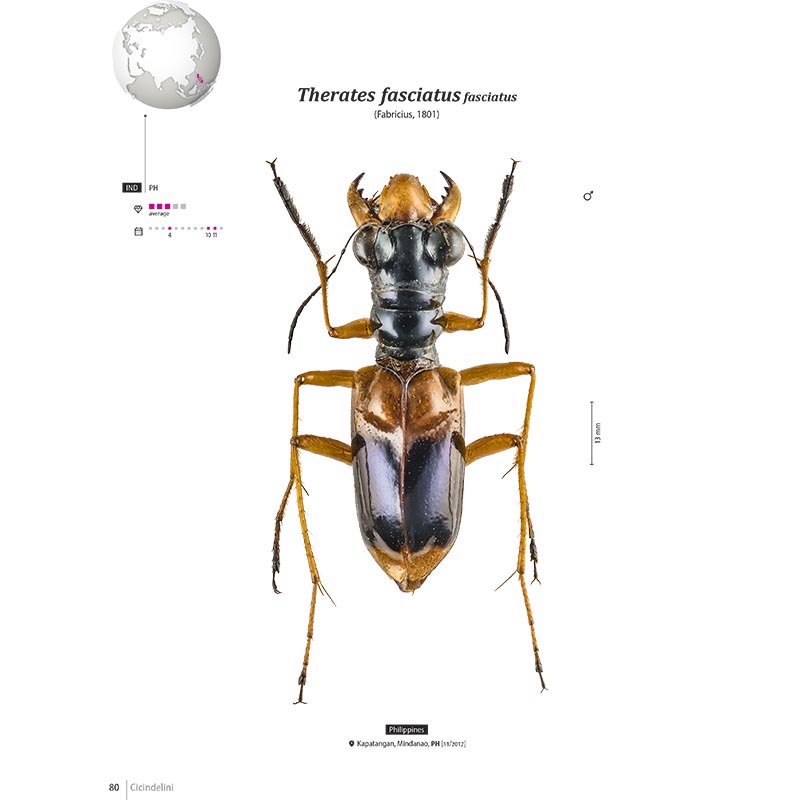
Tiger Beetle Speed and Predators
Tiger beetles are renowned for their incredible speed, with the Australian tiger beetle being the fastest running insect. Its speed is so remarkable that if it were human-sized, it would be faster than a cheetah. However, tiger beetles themselves have predators, such as birds and ants, which feed on their larvae.
Habitat and Diet
Tiger beetles primarily inhabit sandy areas and are important bioindicators of ecosystem health. Their diet consists mainly of small insects and spiders, which they hunt using their speed and powerful jaws. Despite their predatory nature, tiger beetles are not dangerous to humans.
Life Cycle and Species
The life cycle of tiger beetles involves larvae that live in burrows and feed on passing arthropods. Adults emerge in summer and are known for their vibrant colors and agility. There are over 2,600 species of tiger beetles worldwide, each with unique characteristics.
Running Ability and Comparison to Humans
Tiger beetles are incredibly fast runners, with some species reaching speeds that would equate to over 700 mph if scaled to human size. While they are not harmful to humans, their speed allows them to catch prey efficiently, making them vital in maintaining ecological balance.
Safety and Distribution
Tiger beetles are not poisonous and are generally harmless to humans. They are found in various parts of the world, including the UK, and are often seen in open, sandy habitats. The presence of water is crucial for their survival, as it influences their habitat preferences.
Scientific Names and Specific Species
The scientific name for the Australian tiger beetle is Cicindela hudsoni. Other notable species include the Six-spotted Tiger Beetle, which is not poisonous. The Manticore Tiger Beetle is another species, though less commonly discussed in literature.
Tiger beetles are beneficial predators and are not considered dangerous to humans, making them an important part of their ecosystems rather than a threat.
-
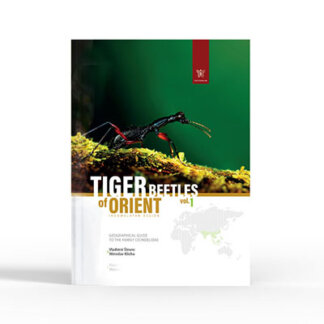 Tiger Beetles of Orient€ 129.00
Tiger Beetles of Orient€ 129.00 -
 Tiger Beetles of Africa€ 129.00
Tiger Beetles of Africa€ 129.00 -
 The Prionids Collection BundleProduct on sale€ 99.00
The Prionids Collection BundleProduct on sale€ 99.00 -
 Ground Beetles of Africa (2nd edition)€ 136.00
Ground Beetles of Africa (2nd edition)€ 136.00 -
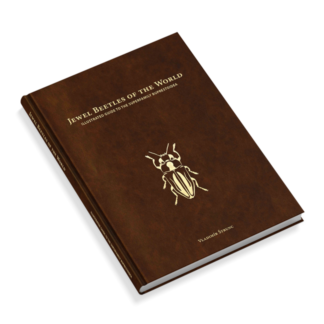 Jewel Beetles of the World€ 105.00
Jewel Beetles of the World€ 105.00 -
 Tiger Beetles of the World€ 109.00
Tiger Beetles of the World€ 109.00
Books about Beetles
Unique pictorial atlases for identifying Beetles:
(2020) Tiger Beetles of the World, Cicindelidae, Illustrated guide to the genera
(2023) Tiger Beetles of Africa, Cicindelidae, Geographical guide to the family Cicindelidae
(2024) Tiger Beetles of Orient, Cicindelidae, Geographical guide to the family Cicindelidae
(2022) Ground Beetles of Africa, Afrotropical Region
(2022) Jewel Beetles of the World, Buprestidae, Illustrated guide to the Superfamily Buprestoidea
(2008) The Prionids of the World, Prioninae, Illustrated catalogue of the Beetles
(2010) The Prionids of the Neotropical region, Prioninae, Illustrated catalogue of the Beetles
Unique pictorial atlases for identifying Beetles. Cicindelidae, commonly known as tiger beetles, represent a diverse group of predatory insects renowned for their remarkable hunting abilities, distinctive appearance, and ecological significance. These beetles, characterized by their vibrant metallic coloration and incredible speed, are found across various habitats worldwide with particularly high diversity in tropical and subtropical regions. Their specialized hunting strategies and unique life cycles have made them subjects of scientific interest for entomologists studying predator-prey dynamics and insect adaptations.
Common tiger beetles
Cicindelidae: The Tiger Beetles
Taxonomic Classification and Diversity
Tiger beetles have undergone some taxonomic reclassification over time, traditionally placed within the family Cicindelidae, order Coleoptera. The complete taxonomic hierarchy positions them within Eukaryota (superkingdom), Animalia (kingdom), Bilateria (subkingdom), Protostomia (infrakingdom), Ecdysozoa (superphylum), Arthropoda (phylum), Hexapoda (subphylum), Insecta (class), Pterygota (subclass), Neoptera (infraclass), Holometabola (superorder), Coleoptera (order), and Adephaga (suborder). Common tiger beetles
More recent classifications, however, consider them as the subfamily Cicindelinae within the family Carabidae (ground beetles). This taxonomic family comprises more than 2,600 species of beetles, organized into numerous genera and tribes including Cicindelini, Collyridini, Ctenostomatini, Manticorini, Megacephalini, and Oxycheilini.
The diversity of tiger beetles continues to be refined through ongoing taxonomic research. For instance, recent molecular and morphological analyses have revealed the need for new genera to accommodate distinct evolutionary lineages. One example is the establishment of Jundlandia, a new genus created to accommodate the unique characteristics of Cylindera lemniscata, which previous studies had difficulty placing within the Nearctic fauna due to its peculiar morphological features. Such taxonomic revisions highlight the complexity and evolutionary diversity within this group.
Regional biodiversity studies further demonstrate the widespread distribution of these beetles. In Pakistan alone, researchers have documented 55 taxa under 14 genera and 11 subgenera, with species like Cylindera albopunctata, Cicindela viridilabris, and Neocollyris redtenbacheri being recorded in the country for the first time in recent years. This continuous discovery of new regional records underscores the wide but still incom
pletely documented global distribution of tiger beetles.
Evolutionary Relationships
The evolutionary relationships among tiger beetles have been investigated using both traditional morphological approaches and more recent molecular phylogenetic studies. These analyses have revealed complex patterns of relatedness among different groups. For example, molecular studies from the late 1990s and early 2000s struggled to reach consensus about the systematic placement of certain species like Cylindera lemniscata, which was later determined through mtDNA genealogy to represent a monotypic clade sister to a larger group of Nearctic tiger beetles.
These phylogenetic studies continue to provide insights into the evolutionary history of tiger beetles, including patterns of adaptive radiation, biogeographic distribution, and morphological specialization across different habitats and ecological niches. The ongoing refinement of tiger beetle taxonomy reflects the dynamic nature of systematic biology and the importance of integrative approaches combining molecular, morphological, and ecological data.
Physical Characteristics
Tiger beetles possess a distinctive combination of morphological features that make them readily identifiable among beetle families. These predatory insects typically have slender, long-legged bodies measuring approximately 10 to 20 mm (0.4 to 0.8 inch) in length. One of their most notable features is their large, bulging eyes that provide exceptional vision – a critical adaptation for their predatory lifestyle that allows them to detect movement quickly in their environment.
The coloration of tiger beetles is particularly striking, with many species displaying iridescent hues of blue, green, orange, or scarlet. This vibrant appearance results from a combination of two factors: pigments embedded within their exoskeleton and structural colors created by the refractory properties of their exoskeletal surface.
This dual mechanism of color production contributes to the metallic sheen that makes many species visually spectacular. The coloration often serves adaptive purposes, with species inhabiting sandy areas frequently displaying lighter colors that match their environment, providing effective camouflage.
Morphological Adaptations
Tiger beetles possess several specialized adaptations that enhance their predatory capabilities. Their most prominent feature is the pair of long, sharp mandibles capable of inflicting painful bites when handled. These mandibles serve as powerful grasping tools for capturing and dismembering prey. The six-spotted tiger beetle (Cicindela sexguttata), a common species in eastern North America, exemplifies the typical morphology with its shiny bluish-green coloration and distinctive pattern of six white markings on its elytra (wing covers).
The wing covers (elytra) of many tiger beetle species, particularly those in the genus Cicindela, feature scroll-like markings that create distinctive patterns. These markings vary considerably between species and can serve as important diagnostic characteristics for identification. The combination of specialized mouthparts, keen vision, and agile body design makes tiger beetles exceptionally effective predators in their respective habitats.
Hunting Behavior and Predatory Adaptations
Tiger beetles have earned their common name from their remarkably aggressive hunting tactics and voracious appetite. Both the larvae and adults are predaceous, though they employ drastically different hunting strategies due to their distinct lifestyles. These beetles have developed specialized adaptations that make them formidable predators within their ecosystems.
Adult tiger beetles are renowned for their exceptional speed and agility. They are among the fastest insects on Earth, with the Australian species Rivacindela hudsoni (formerly Cicindela hudsoni) capable of reaching speeds of 2.5 meters per second (approximately 5.6 mph) or about 125 body lengths per second. This remarkable mobility allows adults to actively pursue and capture prey with impressive efficiency. They patrol open areas, using their excellent vision to detect potential prey, then sprint forward to seize victims with their powerful mandibles.
Larval Hunting Strategy
While adult tiger beetles employ active hunting tactics, the larvae utilize an entirely different approach based on ambush predation. Larvae construct and inhabit vertical burrows or tunnels in hard-packed soil or sand, which can reach depths of up to 60 cm (2 feet). The larva positions itself at the entrance of this burrow, using specialized hooks on the dorsal side of its fifth abdominal segment to anchor itself in place. These hooks serve a dual purpose: they secure the larva at the burrow entrance while waiting for prey and provide stability when dragging struggling prey into the depths of the tunnel.
When potential prey—typically insects or spiders—passes within striking distance, the larva lunges out with remarkable speed, grasping the victim with its sickle-like mandibles. The abdominal hooks prevent the larva from being pulled out of its burrow during the struggle with larger prey. Once captured, the prey is dragged to the bottom of the burrow, where it is consumed. This sophisticated ambush strategy allows the relatively immobile larvae to effectively capture prey while remaining protected from potential predators.
Habitat and Distribution
Tiger beetles demonstrate remarkable ecological versatility, occurring throughout the world across a diverse range of habitats, though the highest species diversity is found in subtropical and tropical regions. Their specific habitat preferences vary considerably between species, but most are typically associated with open, exposed areas that receive ample sunlight. Common habitats include sandy beaches, riverbanks, salt flats, woodland paths, roadways, and forest clearings.
The preference for open, sunny habitats aligns with the beetles’ visual hunting strategy, as their excellent eyesight functions optimally in well-lit environments. Different species have adapted to specific microhabitats, with some specialized to live exclusively in particular soil types or ecological zones. For example, some species prefer sandy coastal areas, while others inhabit clay soils in forest clearings or rocky surfaces in mountainous regions.
Specialized Habitat Adaptations
While most tiger beetles are terrestrial ground-dwellers, ecological specialization has led to the evolution of several alternative lifestyles within the family. Some exotic tropical species have developed associations with termite nests, forming complex ecological relationships with these social insects.
Other tropical species have adapted to arboreal (tree-dwelling) lifestyles, hunting prey on tree trunks and vegetation rather than on the ground. Additionally, certain species have evolved semi-aquatic habits, living near water bodies and sometimes hunting on water surfaces.
The global distribution of tiger beetles encompasses multiple biogeographical realms. Studies from Pakistan have documented species belonging to both Palearctic and Oriental biogeographical zones, highlighting the wide-ranging distribution of these insects. The regional distribution patterns often reflect adaptations to local climatic conditions and habitat availability, with species composition varying significantly between different geographical areas.
Life Cycle and Development
The life cycle of tiger beetles involves complete metamorphosis (holometabolism), progressing through egg, larval, pupal, and adult stages. The reproductive process begins when female tiger beetles select suitable oviposition sites in soil, often in the same habitat types where adults hunt. The female excavates small cavities less than half an inch deep in the soil and deposits single, ovate, translucent eggs.
Upon hatching, the larvae immediately begin constructing their characteristic vertical burrows in the soil or sand. These burrows serve as both protective retreats and hunting platforms throughout the larval development period. Tiger beetle larvae undergo three instars (developmental stages), with the entire larval phase potentially lasting one to three years depending on the species and environmental conditions.
You can find here: Carabidae, Buprestidae, Cicindelidae, Scarabaeidae, Lucanidae, Chrysomelidae, Curculionidae, Staphylinidae
Developmental Adaptations
The larvae exhibit specialized morphological adaptations suited to their ambush predator lifestyle. Most notably, they possess hooks on the dorsal side of their fifth abdominal segment that anchor them securely within their burrows. This adaptation allows them to position themselves at the entrance of their tunnels while remaining firmly attached to the burrow walls. The larvae also develop powerful, sickle-shaped mandibles that function effectively for grasping and subduing prey.
After completing larval development, the final instar larva seals its burrow and pupates within an enlarged chamber at the bottom. Following metamorphosis, the adult beetle emerges from the pupal case and digs its way to the surface. Adult tiger beetles are typically active during warm seasons, with specific activity patterns varying by species. Some species demonstrate seasonal activity cycles, while others may remain active year-round in suitable climates.
Ecological Significance and Conservation
Tiger beetles serve as important predators within their ecosystems, contributing to the regulation of various insect populations. Their voracious appetite for smaller arthropods makes them valuable components of natural pest control systems. Additionally, as both predators and potential prey for larger animals, they form crucial links in ecological food webs.
Beyond their ecological functions, tiger beetles have attracted scientific interest as potential bioindicators of environmental quality. Their specific habitat requirements and sensitivity to environmental disturbances make certain species useful indicators of ecosystem health. Changes in tiger beetle populations or community composition may signal broader ecological changes or degradation.
Despite their ecological importance, some tiger beetle species face conservation challenges due to habitat loss, pollution, and climate change. Their often specialized habitat requirements make them vulnerable to environmental alterations. While some species have been transported to other countries for potential biological control applications, these efforts have not yielded significant practical results.
Conclusion Cicindelidae
Cicindelidae (tiger beetles) represent a fascinating group of predatory beetles characterized by their striking appearance, remarkable hunting abilities, and ecological adaptations. Their taxonomy continues to evolve as new research illuminates evolutionary relationships among species, while their global distribution demonstrates successful adaptation to diverse habitats across multiple biogeographical regions.
The specialized hunting strategies employed by both adults and larvae highlight the evolutionary refinement of predatory behaviors within this group. Adult tiger beetles, with their exceptional speed and visual acuity, represent some of the most efficient insect predators, while the ambush tactics of larvae demonstrate alternative adaptations to predatory lifestyles.
Future research on tiger beetles may yield additional insights into their evolutionary history, ecological relationships, and potential applications in conservation biology. As indicators of ecosystem health and components of natural pest control systems, these remarkable insects merit continued scientific attention and conservation consideration. Their combination of aesthetic appeal and biological significance makes them valuable subjects for both scientific study and biodiversity conservation efforts.
You can find here: Carabidae, Buprestidae, Cerambycidae, Scarabaeidae, Lucanidae, Chrysomelidae, Curculionidae, Staphylinidae






Family Cicindelidae: Advantages and Disadvantages
Introduction
The family Cicindelidae, commonly known as tiger beetles, consists of over 2,600 species of beetles recognized for their predatory habits and impressive speed. These beetles are found worldwide, often inhabiting sunny, sandy areas near bodies of water. This article will explore the advantages and disadvantages associated with the family Cicindelidae.
Advantages
-
Ecological Role: Predation
Tiger beetles are voracious predators, feeding on a variety of insects and spiders. This helps maintain ecological balance by controlling pest populations, which can be beneficial for agriculture and natural ecosystems. -
Biodiversity Indicators
Due to their sensitivity to environmental changes, tiger beetles serve as excellent indicators of biodiversity and ecosystem health. -
Speed and Agility
Tiger beetles are among the fastest insects on Earth, with some species reaching speeds of up to 2.5 meters per second. This speed allows them to efficiently hunt and evade predators. Their agility and rapid movement make them fascinating subjects for scientific study, particularly in the fields of biomechanics and sensory perception. -
Diverse Habitats
Tiger beetles inhabit a wide range of environments, from sandy beaches to woodland paths, contributing to their ecological diversity and adaptability.
Disadvantages
-
Predation Pressure
While tiger beetles help control pest populations, they can also exert significant predation pressure on beneficial insects. This might disrupt local food chains if their populations become too dominant. -
Potential for Overexploitation
The larvae of tiger beetles are often targeted by parasitic wasps, which can lead to overexploitation of certain tiger beetle species. This could impact their populations and ecological roles. -
Limited Defensive Mechanisms
Despite their speed, tiger beetles have limited defensive mechanisms against larger predators. Their reliance on speed and agility makes them vulnerable in certain situations. -
Environmental Sensitivity
Tiger beetles are sensitive to environmental changes, which can make them vulnerable to habitat destruction and climate change. This sensitivity, while useful for monitoring ecosystems, also poses a threat to their survival. -
Bug Posters, Insect Posters
Conclusion
The family Cicindelidae offers numerous ecological benefits, including pest control and biodiversity monitoring. However, their predation activities and environmental sensitivity also present challenges. Understanding these aspects is crucial for managing ecosystems effectively and ensuring the long-term survival of these fascinating insects.

Tiger Beetle Speed and Predators
Tiger beetles are renowned for their incredible speed, with the Australian tiger beetle being the fastest running insect. Its speed is so remarkable that if it were human-sized, it would be faster than a cheetah. However, tiger beetles themselves have predators, such as birds and ants, which feed on their larvae.
Habitat and Diet
Tiger beetles primarily inhabit sandy areas and are important bioindicators of ecosystem health. Their diet consists mainly of small insects and spiders, which they hunt using their speed and powerful jaws. Despite their predatory nature, tiger beetles are not dangerous to humans.
Life Cycle and Species
The life cycle of tiger beetles involves larvae that live in burrows and feed on passing arthropods. Adults emerge in summer and are known for their vibrant colors and agility. There are over 2,600 species of tiger beetles worldwide, each with unique characteristics.
Running Ability and Comparison to Humans
Tiger beetles are incredibly fast runners, with some species reaching speeds that would equate to over 700 mph if scaled to human size. While they are not harmful to humans, their speed allows them to catch prey efficiently, making them vital in maintaining ecological balance.
Safety and Distribution
Tiger beetles are not poisonous and are generally harmless to humans. They are found in various parts of the world, including the UK, and are often seen in open, sandy habitats. The presence of water is crucial for their survival, as it influences their habitat preferences.
Scientific Names and Specific Species
The scientific name for the Australian tiger beetle is Cicindela hudsoni. Other notable species include the Six-spotted Tiger Beetle, which is not poisonous. The Manticore Tiger Beetle is another species, though less commonly discussed in literature.
Tiger beetles are beneficial predators and are not considered dangerous to humans, making them an important part of their ecosystems rather than a threat.
-
 Tiger Beetles of Orient€ 129.00
Tiger Beetles of Orient€ 129.00 -
 Tiger Beetles of Africa€ 129.00
Tiger Beetles of Africa€ 129.00 -
 The Prionids Collection BundleProduct on sale€ 99.00
The Prionids Collection BundleProduct on sale€ 99.00 -
 Ground Beetles of Africa (2nd edition)€ 136.00
Ground Beetles of Africa (2nd edition)€ 136.00 -
 Jewel Beetles of the World€ 105.00
Jewel Beetles of the World€ 105.00 -
 Tiger Beetles of the World€ 109.00
Tiger Beetles of the World€ 109.00
